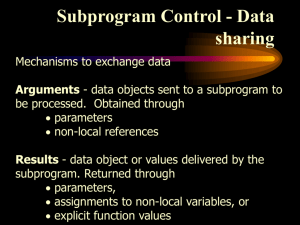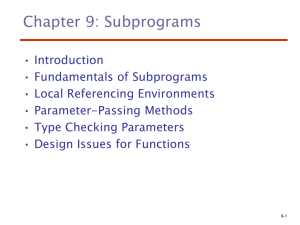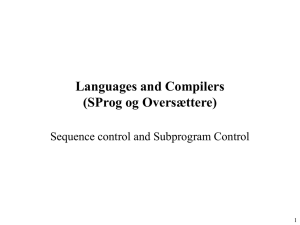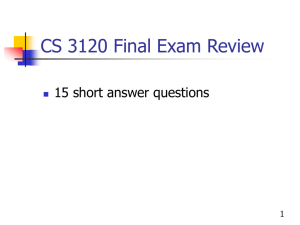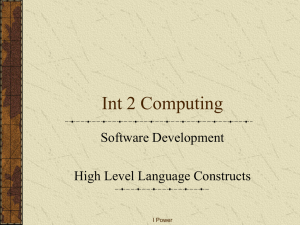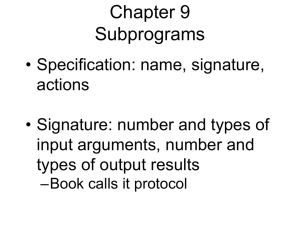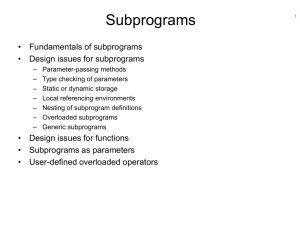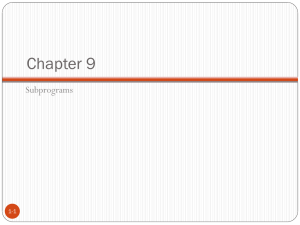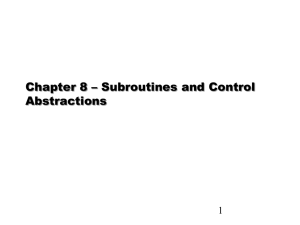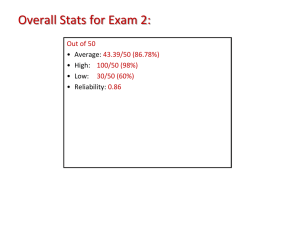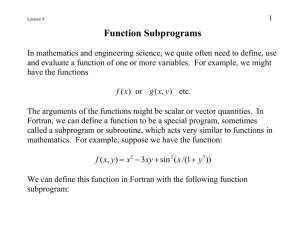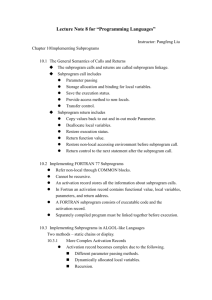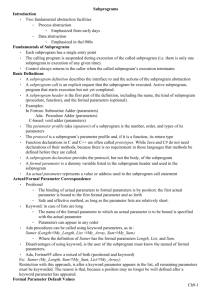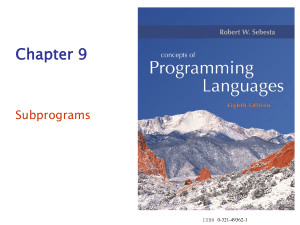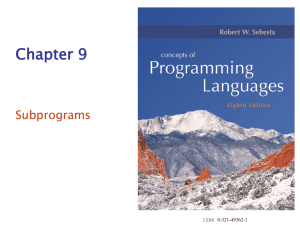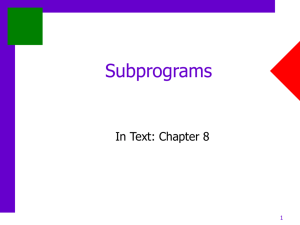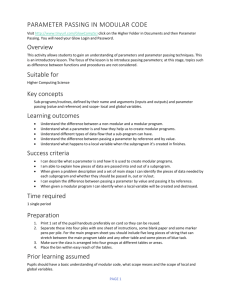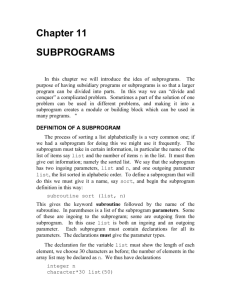Lecture note 7
advertisement
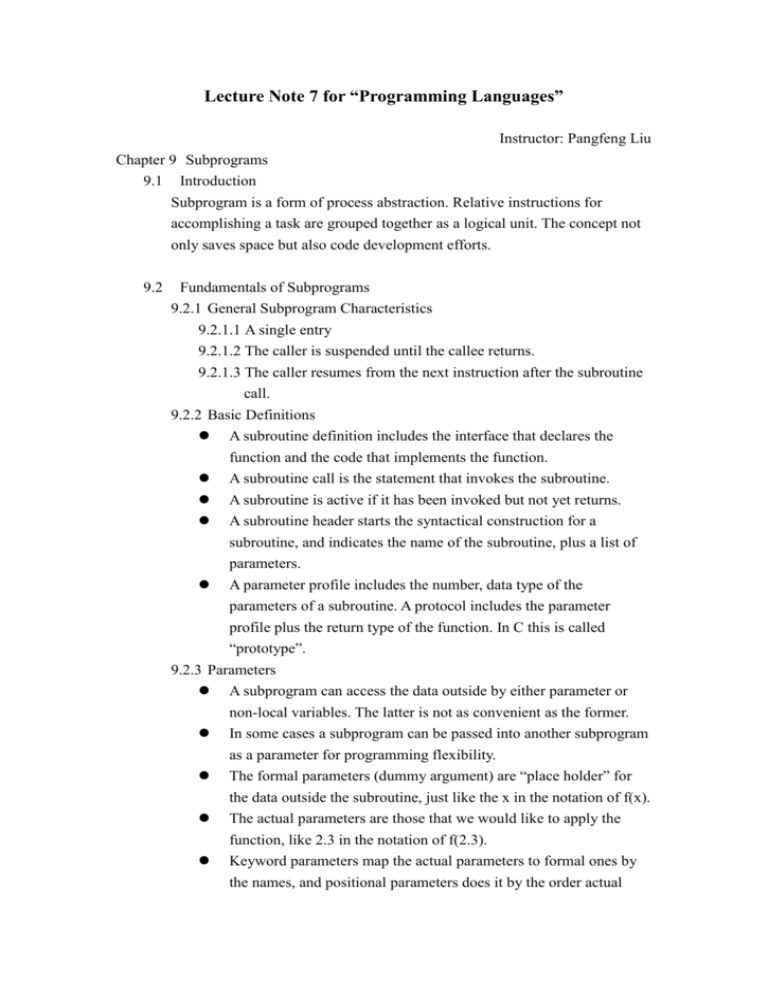
Lecture Note 7 for “Programming Languages” Instructor: Pangfeng Liu Chapter 9 Subprograms 9.1 Introduction Subprogram is a form of process abstraction. Relative instructions for accomplishing a task are grouped together as a logical unit. The concept not only saves space but also code development efforts. 9.2 Fundamentals of Subprograms 9.2.1 General Subprogram Characteristics 9.2.1.1 A single entry 9.2.1.2 The caller is suspended until the callee returns. 9.2.1.3 The caller resumes from the next instruction after the subroutine call. 9.2.2 Basic Definitions A subroutine definition includes the interface that declares the function and the code that implements the function. A subroutine call is the statement that invokes the subroutine. A subroutine is active if it has been invoked but not yet returns. A subroutine header starts the syntactical construction for a subroutine, and indicates the name of the subroutine, plus a list of parameters. A parameter profile includes the number, data type of the parameters of a subroutine. A protocol includes the parameter profile plus the return type of the function. In C this is called “prototype”. 9.2.3 Parameters A subprogram can access the data outside by either parameter or non-local variables. The latter is not as convenient as the former. In some cases a subprogram can be passed into another subprogram as a parameter for programming flexibility. The formal parameters (dummy argument) are “place holder” for the data outside the subroutine, just like the x in the notation of f(x). The actual parameters are those that we would like to apply the function, like 2.3 in the notation of f(2.3). Keyword parameters map the actual parameters to formal ones by the names, and positional parameters does it by the order actual parameters appear. Using keyword parameters requires the knowledge of parameter names, but is more readable and reliable. Parameters may have default values. They must appear last in the parameter list so that the compiler can determine the mapping. 9.2.4 Procedure and Functions A procedure prescribes a group of instruction for parameterized computation, and defines a new statement. A procedure produces results by altering either the parameters or the non-local variable since it does not have return value. A function models after a mathematic relation between a set of parameters and a return value, therefore a function defines a new operator. A pure function produces result not by side effects, but by the return value. Otherwise a function could work just like a procedure by side effects. 9.3 Design Issues for Subprograms Parameter-passing methods Type checking for parameters Local variable allocation Referencing environment for the subprograms that were passed into another subprogram. Parameter type checking for the subprograms that were passed into another subprogram. Nested subprogram definition Overloaded subprograms Generic subprograms Separate or independent compilation 9.4 Local Referencing Environments Could be static or dynamic. Static locals are history-sensitive, efficient, but do not support recursion. 9.5 Parameter-passing Methods 9.5.1 Semantics Models of Parameter Passing The semantic models are possible – in, out, inout. The actual parameters are brought in, moved out, or brought in and moved out respectively. 9.5.2 Implementation Models of Parameter Passing 9.5.2.1 Pass-by-Value In mode Actual parameters are copied into a new storage in the subprogram when it starts. The access is efficient but the copying is not. 9.5.2.2 Pass-by-Result Out mode The result in the subprogram is copied into the actual parameter when the subroutine returns. Could cause problems when the same actual parameter is mapped to multiple formal parameters, or when the actual parameter is a constant, which could be changed when the subprogram returns. 9.5.2.3 Pass-by-Value-Result Inout mode. Combine pass-by-value and pass-by-result. Also called pass-by-copy. 9.5.2.4 Pass-by-Reference Inout mode. Different from pass-by-value-result, a data access path is passed into the subprogram, not the data itself. Parameter passing is efficient, but accessing is not. May introduce unexpected alias when an actual parameter is mapped to different formal parameters, or a global variable is passed into a subprogram where the global variable is visible. 9.5.2.5 Pass-by-Name 9.5.2.5.1 Inout mode. 9.5.2.5.2 The occurrence of formal parameter is textually replaced by the actual parameter. 9.5.2.5.3 The access method is bound at the subprogram invocation, but the evaluation is carried out every time the formal parameter is encountered. 9.5.2.5.4 If the actual parameter is a scalar variable, then pass-by-name is the same as pass-by-reference. 9.5.2.5.5 If the actual parameter is a constant, it is equivalent to pass-by-value. 9.5.2.5.6 If the actual parameter is an array reference or an expression with variables, then it is evaluated every time it is encountered. This is called lazy evaluation or late binding. 9.5.3 Parameter-Passing Methods of Major Languages Fortran: Pass-by-reference before F77, pass-by-value-result afterwards. ALGOL 60: Pass-by-name and pass-by-value. C: Pass-by-value, pass-by-reference is emulated by passing pointers. C++: Pass-by-value plus pass-by-reference with reference data type. Java: Pass-by-value for scalar and pass-by-reference for objects since no pointer available. ALGOL-W: First use of pass-by-value-result. Pascal: Pass-by-value and pass-by-reference. 9.5.4 Type-Checking Parameters The number and types of parameters should be checked. C/C++ provide the information through prototype. 9.5.5 Implementing Parameter-Passing Methods 9.5.5.1 All major parameter-passing methods could be implemented with the program stack. See Figure 9.2 for illustration. 9.5.5.2 There are differences between pass-by-reference and pass-by-value-result since the latter allocates full storage for the formal parameter. The changes made to the actual parameters will be visible only when the subprogram is over, but the pass-by-reference will reflect the change every step away. 9.5.5.3 Pass-by-name is implemented as a thunk code segment, which is bound to a referencing environment when the subprogram is called, and is evaluated for every occurrence of the formal parameter. 9.5.6 Multi-dimensional Arrays as Parameters The subprogram must be able to calculate the correct address for all possible actual parameters. C can accomplish this for single dimensional array using pointer arithmetic. In Ada or Java the array type includes the descriptor for dimensional information. In Fortran the formal parameter must declare the dimensional information, and it is the user’s responsibility to pass the array with correct size. 9.5.7 Design Considerations Efficiency One or two-way communication. 9.5.8 Examples See the textbook. Pay attention to when the actual parameters are evaluated for those methods that pass data access path, rather than the data. The pass-by-copy will copy result back to actual parameter, and produce unexpected results. 9.6 Functions Parameters The prototype must be checked for actual parameter that is a 9.7 subprogram. The referencing environment for the subprogram A that is passed into another subprogram B can be as follows. Shallow binding – the environment (within B) A is called. Deep binding – the environment A is defined. Ad Hoc binding – the environment where A is passed into B (where B is called). Block structured language usually uses deep binding for easy adoption into static scooping. Overloaded Subprograms The subprograms that have the same name but different prototypes (or parameter profile in some cases). In Ada the compiler can distinguish usage by the return type, so two overloaded subprogram can have the same parameter profile, while in other languages that allow mixed-mode expression, the entire prototype must be considered. 9.8 Generic Subprograms Polymorphism means the same construct can have different meanings according to the context. Ad hoc polymorphism – operator overloading. Parametric polymorphism – a generic program that works on different types of variables by given type parameters. 9.8.1 In Ada Generic unit for a program that implements parametric polymorphism. 9.8.2 In C++ Called template in C++ and provides programming flexibility. The functions are built upon usage (in header file, not in source file). 9.9 Separate and Independent Compilation 9.9.1 Separate compilation requires module-to-module consistency checks. This can be implemented as a part of library built from compilation, as in Ada, or manually maintained as header files as in C/C++. 9.9.2 Independent compilation does not require information from other modules. The module is compiled with the hope that the usage and implementation will be consistent, as in Fortran 77 or C. 9.10 Design Issues for Functions 9.10.1 Side Effects 9.10.2 Type of Return Values 9.11 Accessing Non-local Environments Static scooping and dynamic scooping were described earlier in Chapter 5. 9.11.1 Fortran COMMON Blocks The COMMON block creates alias and may put data of different types together. 9.11.2 External Declarations and Modules Fortran 90 has the “module” concept and can provide non-local data access. C/C++ has various scooping rules for access non-locals. 9.12 User-defined Overloaded Operators A convenient feature that improves readability if used properly. 9.13 Coroutines The control is switched among several processes. A process is “resumed”, and it does not return. Usually a master process creates other processes, and dispatch control among them.
